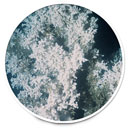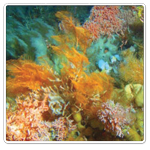Climate change
 In the deep sea, cold-water coral reefs are important habitat for a wide variety of species, and may form essential fish nursery and feeding grounds. Changes in the concentration of aragonite may impact reefs at higher latitudes by reducing the depth of the aragonite saturation horizon (ASH). One key difference between the two major oceans of the world, the Pacific and Atlantic, is the depth of the ASH. The Pacific has a shallower ASH which may restrict the formation of aragonite skeletons, such as those of scleractinian corals. In the deep sea, cold-water coral reefs are important habitat for a wide variety of species, and may form essential fish nursery and feeding grounds. Changes in the concentration of aragonite may impact reefs at higher latitudes by reducing the depth of the aragonite saturation horizon (ASH). One key difference between the two major oceans of the world, the Pacific and Atlantic, is the depth of the ASH. The Pacific has a shallower ASH which may restrict the formation of aragonite skeletons, such as those of scleractinian corals.
 Coral communities in the Pacific are dominated by solitary octocorals and hydrocorals, a contrast to the large scleractinian reef structures in the North Atlantic, where the ASH is much deeper. Models of the projected aragonite saturation show that ca. 70% of current known cold-water coral locations could be undersaturated by 2099. In short, the effects of climate change could be great, but more research needs to be conducted to determine the sensitivity of deep-sea biota and to understand the time-scale of climate change in the deep-sea. Coral communities in the Pacific are dominated by solitary octocorals and hydrocorals, a contrast to the large scleractinian reef structures in the North Atlantic, where the ASH is much deeper. Models of the projected aragonite saturation show that ca. 70% of current known cold-water coral locations could be undersaturated by 2099. In short, the effects of climate change could be great, but more research needs to be conducted to determine the sensitivity of deep-sea biota and to understand the time-scale of climate change in the deep-sea.
You can find out more about the aragonite saturation horizon and its impacts on cold-water corals by reading the literature: Guinotte et al. 2006 and Orr et al. 2005.

|
